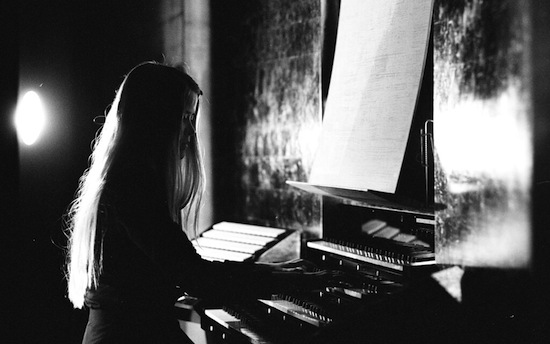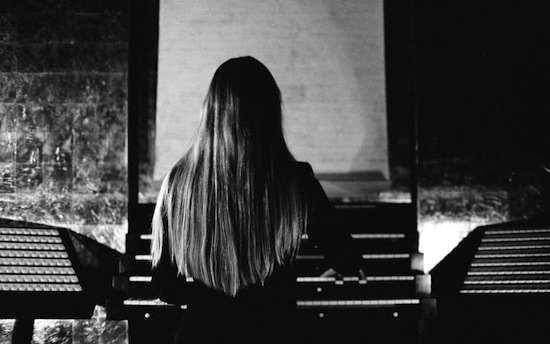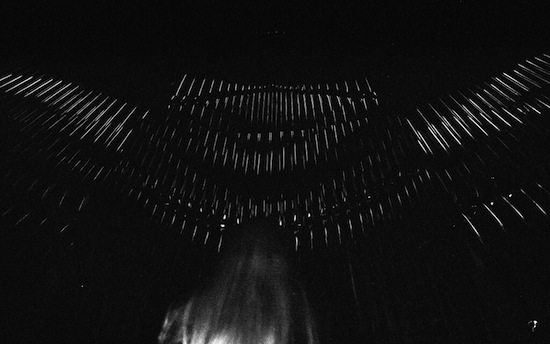The picturesque Swedish village of Piteå lies approximately 100 miles south of the Arctic Circle. In summer, Piteå is a bustling seaside resort, while in the darkness of winter it serves as a handy pit stop for adrenaline-fuelled snowmobilers.
Piteå is also the home of the colossal Acusticum Pipe Organ. Inaugurated in 2012, and built by the renowned German organ builder Gerald Woehl, the Acusticum’s 9,000 pipes make it one of the largest in Europe. However, it is the instrument’s roll call of quirky features that elevates it above an ordinary church organ. The Acusticum contains a built-in glockenspiel, a vibraphone, a celeste, several percussion options and a section of pipes housed in a water bath.
Moreover, it was on the Acusticum that Anna von Hausswolff recorded her extraordinary new album, The Miraculous. It’s a titanic listen – a huge, brooding record that fuses ethereal fantasy with the portentous drama of rumbling organ drone – and a magnificent follow-up to 2013’s Ceremony, an album that itself cemented the reputation of the Gothenburg musician to the extent that she recently featured in David Byrne’s Meltdown festival.
The genesis of The Miraculous is a tangled backstory. Inspired in parts by a previous song she had written (the 20-minute epic, ‘Källan’), a book by the same name (by Swedish author Walter Ljungquist), a Russian war film (1985’s Come And See) and, most intriguingly, a magical childhood place that Anna still visits regularly and that she calls the ‘miraculous’. Anna talks about the place with a sense of wonder; the unnamed spot is an area of breathtaking natural beauty and once provided the backdrop to a bloody uprising, and is now entwined with fantastical stories created by family von Hausswolff.
It’s the second time Anna and I have spoken for tQ, and while The Miraculous may sound like a record created by someone arm-wrestling Armageddon, Anna is a blast; laughing, joking and singing her way through our chat, although she admits – with a mischievous smile – that as ours is her first interview about The Miraculous she is “a bit nervous”.
After the ‘official’ interview ends, we keep talking. Anna and I discover we share a talent. We are both really bad DJs and can clear a dancefloor within the three opening bars of any obscure My Bloody Valentine B-side. We hatch a plan to change her fortunes (I am eternally doomed) – the next time she DJs, Anna will play nothing but Michael Jackson (I had suggested Prince). The punters will dance into the early hours with not a single pipe organ for company. That would be miraculous.

Just after we spoke in 2013 you were about to perform your first show on a pipe organ at Lincoln Cathedral. I saw some footage from the show and it looked amazing. How was the experience?
Anna von Hausswolff: In all, it was an amazing experience and I learned a lot through playing that show, specifically about how to handle catastrophic scenarios.
Catastrophic scenarios? What happened?
AVH: The cathedral staff there were very concerned about the Henry Willis organ, which is a legendary instrument. They were concerned about the organ and a little bit concerned about me and my type of music. I had two days of practice on the organ beforehand. When I finished practicing, I got an email from Mike Harding, who had invited me to play the show, as he had gotten some complaints from the church staff. They said that I played too loud and that I wasn’t allowed to play on certain reed pipes. Towards the end of one of the pieces, ‘Källan’, I almost only use reed pipes. Therefore, I had to rearrange the piece the next day.
That’s not good.
AVH: It gets worse – 30 minutes before the show I am sitting and preparing the organ. Mike Harding comes to me looking devastated and tells me the staff had heard me practice and that they still think I am playing too loudly and they won’t allow me to use any of the reed pipes at all. It was unbelievable. It was the first time I was going to perform my pieces in front of an audience on a real pipe organ and I panicked. I needed to accept what the staff were saying as if I broke the organ I wouldn’t be invited to play a pipe organ show ever again.
What did you do?
AVH: I totally improvised the second part of the piece ‘Källan’ in front of the audience and, while it was very scary, it went really well. It was a new kind of audience for me as it was an experimental music festival where I thought people might be listening in a more thorough way. I thought they might see through me and think me an amateur, but I was very focussed on the sounds I was making, and as ‘Källan’ is quite a slow piece, I had time to think about the next part. I learned that in those situations even if things take an unexpected turn, you can work your way from that point. After the show, after I got a good response. The feedback got me back on my feet and I realised that I am way too hard on myself sometimes and I need to learn to let go of control, and to not think to negatively of myself and to dare to dive into these uncertain situations.
I believe the ‘Källan’ piece was inspired a book of the same name by the author Walter Ljungquist. I don’t know the book. What is it about?
AVH: I really love the book. I read it when I was touring with Efterklang in 2013. It’s about kids on a spiritual journey – they are looking for a ‘life source’ and the book is about the excitement and disappointment of the search. For me, it’s a book about curiosity and the possibility that there is something more to this world than what you currently know. It’s about the realisation that even if you don’t find what you are looking for, there is something useful that you can learn from any situation.
Isn’t that what happened that night in Lincoln?
AVH: Absolutely, I think you can make that connection between what happened that night and the theme of the book. Especially the importance of not judging yourself too harshly of being afraid of failing. I can use that knowledge in other life situations. I recently played in London at David Byrne’s Meltdown, where I played on the Royal Festival Hall organ – which is enormous and a lot bigger than the Henry Willis organ in Lincoln Cathedral – and even to approach an organ like that you have to let go of all of your negativity.
If we turn to your new album, I believe one of the inspirations for The Miraculous was a place you would regularly visit as a child. Can you tell me a little bit about why this place left such an impression on you?
AVH: The ‘miraculous’ place helped me to use my imagination in my surroundings, because the border between fantasy and reality was so blurred. I would go into character all the time when I was a kid, especially when I was at the ‘miraculous’ place. There were so many stories about the place. It felt like everything and anything could happen there and it fed my imagination. I started to create my own stories and I think it was important for my creativity both as a child but also as an adult.
And it is a real place?
AVH: Yes, it is a real place in Sweden – it’s not just in my imagination – and I would go there in the summer and winter. However, the magic is not just about the stories; it’s also about the place. There is something about the natural beauty that makes you want to create stories, and to believe. It’s a combination of the environment and the history – when these aspects combine it makes a very magical feeling.
You’ve also mentioned the 1985 film Come And See as a major source of inspiration for you while you created The Miraculous. What is it about that film?
AVH: The Come And See film is by Russian director Elem Klimov, and it’s about the German occupation of Belorussian SSR. It’s a very brutal and horrifying story about war. It’s a really heavy film, but I think what makes it so special to me is the combination of the story and the natural beauty of the area. The nature is amazing – huge pine trees, beautiful fields of grass and flowers – and the juxtaposition of the landscape and the horrible images of war is very strong. The images that stuck in my head are not so much about the war and the blood but of the beautiful forest, which reminds me of the landscape of the ‘miraculous’ place. They are very similar. There is also a connection to war – as there had been a historical uprising with terrible bloodshed in the ‘miraculous place’. For me, the film suggests the idea of a beautiful place, with such fantastic nature, could have been once where thousands of people were killed.
It’s fascinating that places like that can never just go back to be a field or a beach. Do you feel the weight of history when you are at the ‘miraculous’ place?
AVH: It does affect the way of looking at that place. I always see it through a filter of images. I see scenes in that place, because of the weight of history, even though I wasn’t part of the time when the uprising took place. There is a heaviness. That’s why I can make the connection to the movie and how people in the place that was Belorussia feel about their connection to nature after what happened there during the war. Maybe that’s a subject for another record.
I think PJ Harvey’s peerless Let England Shake delves deeply into a similar theme.
AVH: Yes. It’s amazing that you mention that record as I think it is one of the records that has been the most important to me over the last few years. It’s her best record and the atmosphere of the record is so clear and defined. Every time I listen to that record, I get shocked by how good it is.

So, let me begin to piece these strands together. How did the book, the film and the childhood holiday place help create the soundscape for The Miraculous?
AVH: During the time I read the book and was watching the film, I had started to play ‘Come Wander With Me/Deliverance’ and I had started to write ‘Källan’. These two tracks triggered an entry into a new soundscape that still feels quite different to me. I wanted to linger on those songs and the harshness of those songs. I wanted to build on their flow and the song structure, in a sense that a song could be chopped into parts but still feel connected. I have a new version of ‘Källan’, it’s a 20-minute instrumental piece and it was important in the creation of the new album.
And how did you first get to hear about the Acusticum?
AVH: I got a request from Acusticum to do a show there. This was just after I had released Ceremony the second time around in 2013. When I got the request, I said no, as I felt too much of a newbie. But, I liked the idea of playing on the organ. I read about it and it seemed amazing. It is huge – it has the 9,000 pipes, which is the same number of pipes as the Festival Hall organ in London. The organ is relatively new; it was inaugurated in 2012, and has many uncommon features.
And those features include ‘pipes half covered in water’. What does that sound like? Bubbles?
AVH: Yes. They had a water bath and the top of the pipes are in the water. The sound comes out in the water and exits through the bubbles and that’s what makes the bird-like, high-pitched, screaming sound on ‘The Hope Only Of Empty Men’.
So, how do you approach a 9,000-pipe organ that contains a built-in glockenspiel, vibraphone, celeste and water pipes? You must have been like a kid let loose in the world’s biggest sweet shop.
AVH: I tried everything. I went nuts. I arrived on the first day and I was supposed to do the arrangements for all the songs, but I ended up trying every single feature in the organ.
Can you have too many stimuli?
AVH: No, I think it sparks your creativity even more when you have all these uncommon and unusual features because you have tons of possibilities. Instead of feeling insecure and restrained, I knew it was going to be [sings] ‘awesome’. For me, songwriting is a working method of going back and forth, so sometimes you find a melody and then you find a word, then you find another word that might change the melody. It’s a puzzle that fits together, but always with that particular place in mind so that everything is related to that space.

You recorded a hugely complex album in just five days. Was that a challenge?
AVH: A great challenge. Even though the organ had many cool features, it turned out to be quite hard to record. When we recorded Ceremony we were in a church, which was a big space that gave a very airy sound and meant the organ really came through on the recording. Acusticum is a concert hall, with isolation plates in the walls and ceilings and made the sounds very isolated, so on the recording we tended to lose some of the high frequencies of the pipe organ. It meant a lot of rearranging microphones and trying new types of mikes.
Can I ask about your vocals on the album? You seem to have unleashed your voice compared to previous records. Would you agree?
AVH: I do feel a little bit more comfortable with my voice. I have been practising a lot for the last three years. The practising has changed my voice a little and I have learned there is much more to my voice that I had previously thought. I feel more comfortable playing with my voice and not having to feel controlled all the time. I loosen myself up and don’t worry about the consequences. With the lyrics, I had a very similar approach to before – keep them very simple and direct so that I can easily connect to them when I sing.
So, assuming you don’t have a 9,000-pipe organ you can lug around, how will your translate The Miraculous into the live setting?
AVH: I will tour with the organ I have used before, which is a Nord C2 with pipe organ sounds. You cannot really compare the pipe organ concerts with rock club synth organ shows. When you sit at a pipe organ, you have your back to the audience and you become more introverted. When you are in a rock club, you are facing the audience and everything becomes more extroverted and, in some ways, more expressive. It is two different type of energies.
I think I’m done with all my questions.
AVH: You haven’t asked me about my new label, Pomperipossa.
Oh. Anna, tell me about your new label, Pomperipossa.
AVH: [Laughs] I feel like I am doing a commercial. I am releasing a Swedish artist called Berg. It is minimalistic drone music and it will be a cassette for the first release for Pomperipossa.
Why did you feel the need to start your own label?
AVH: I think it is just a way of connecting to other musicians that I share a certain kinship. I am a solo artist, and although I have a band, it is my project and I can feel isolated within the context of the project. I don’t have the camaraderie and I miss that.
I suppose artists that make music on pipe organs are a just a little bit niche.
AVH: I think so. It would be great to hang out with 20 people all making similar music, but I think I maybe need to find a selection of artists on Pomperipossa that are musically schizophrenic.
The Miraculous is out on November 13 via City Slang. Anna Von Hausswolff plays Oslo, London, on December 8



